Abstract
A sensitive time-resolved fluoroimmunoassay (TR-FIA), adapted from TR-FIA procedures already described, was developed with monoclonal antibodies and compared with several enzyme immunoassays (EIAs) for detecting adenovirus antigens in clinical specimens. The most sensitive EIA was an all-monoclonal assay with biotin-labeled detector antibody and streptavidin-peroxidase conjugate. All tests were evaluated with nasopharyngeal aspirate specimens from respiratory illness, with tissue homogenates from patients with systemic infection, and with stool specimens from gastrointestinal illnesses. For respiratory and tissue specimens, the TR-FIA detected adenovirus in 85% of the specimens positive by culture, which was a sensitivity similar to those of the all-monoclonal biotin-avidin EIA (79%) and the polyclonal-capture biotin-avidin EIA (88%). For stool specimens, the TR-FIA detected adenovirus in 100% of the specimens positive by culture, which was a decidedly higher sensitivity than either EIA format (78 and 75%, respectively). The TR-FIA was shown to be an efficient, flexible, and specific test for large numbers of clinical specimens.
Full text
PDF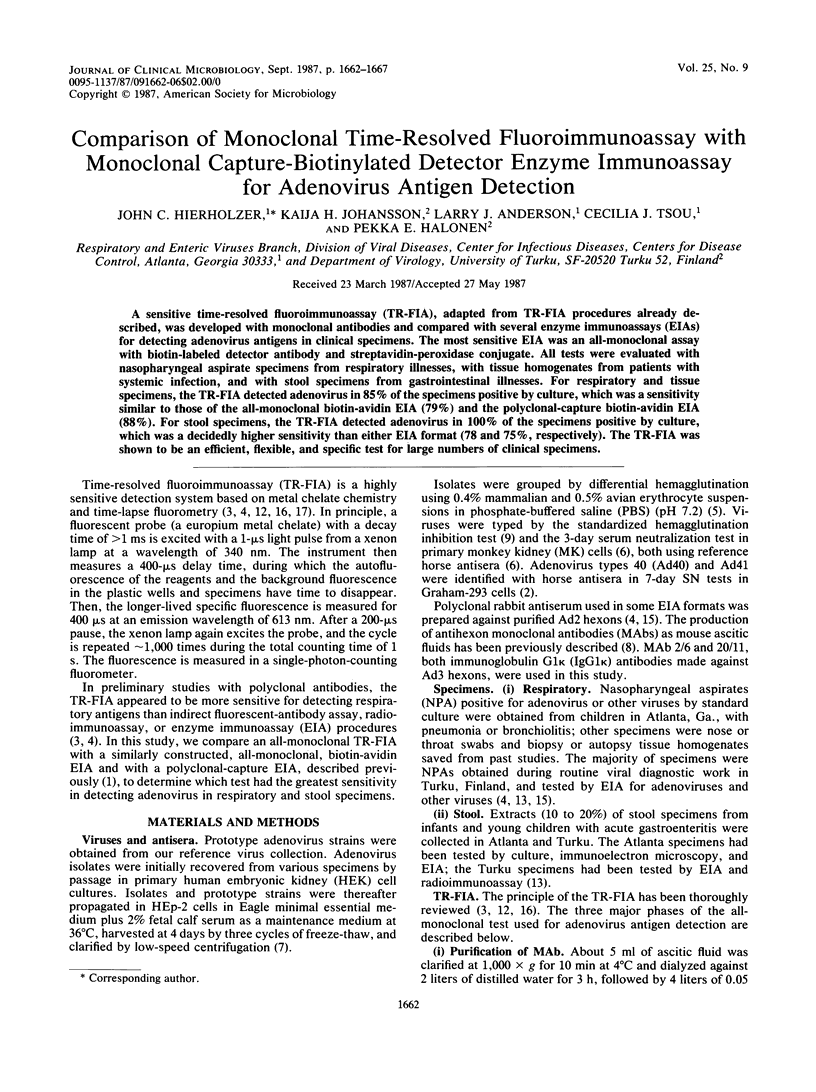
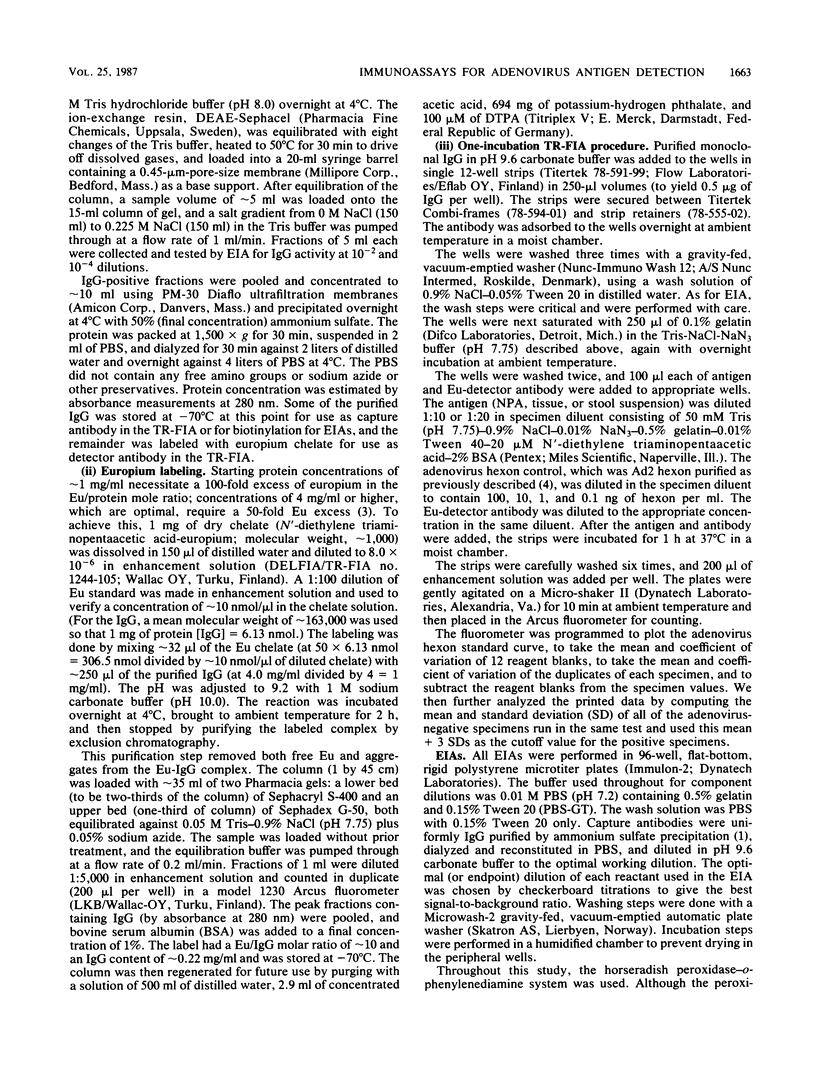
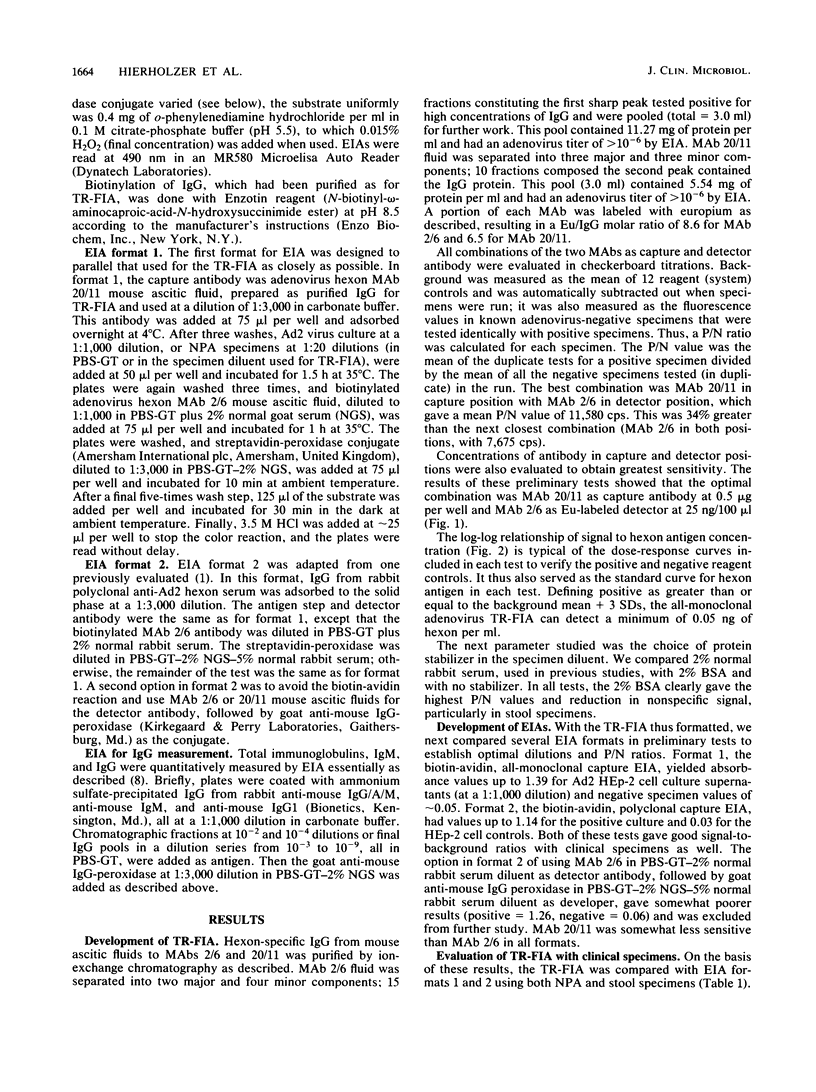
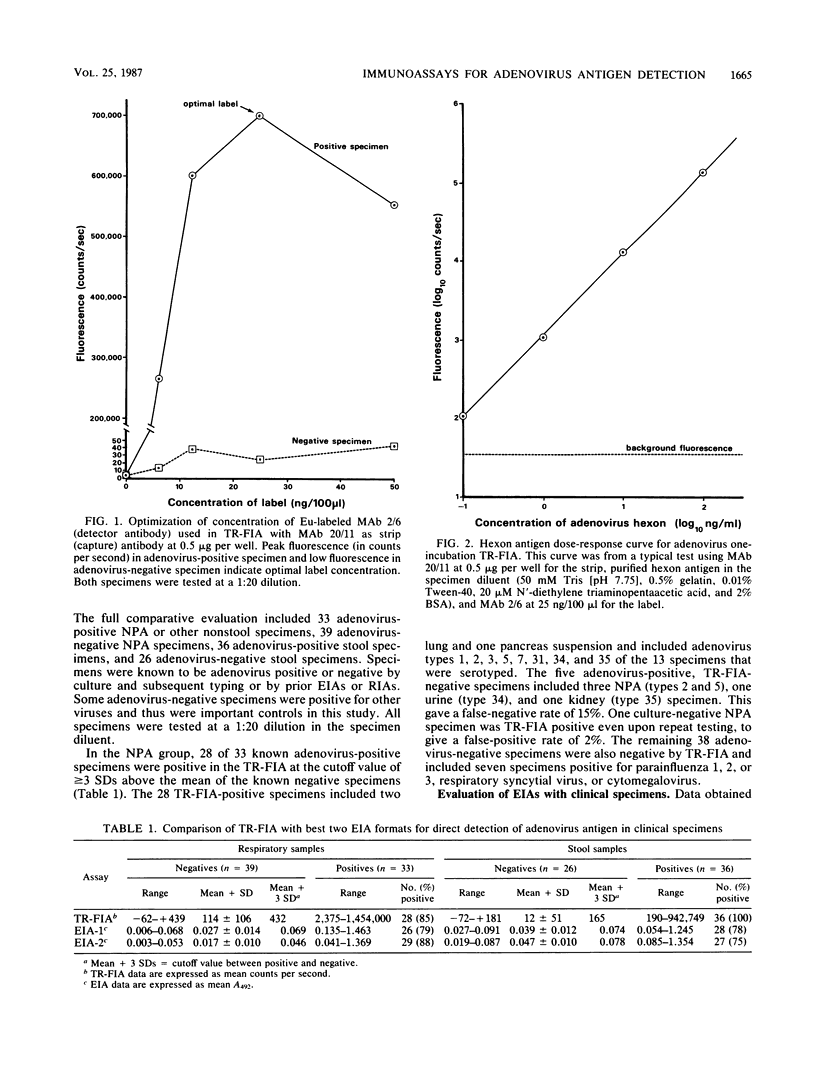
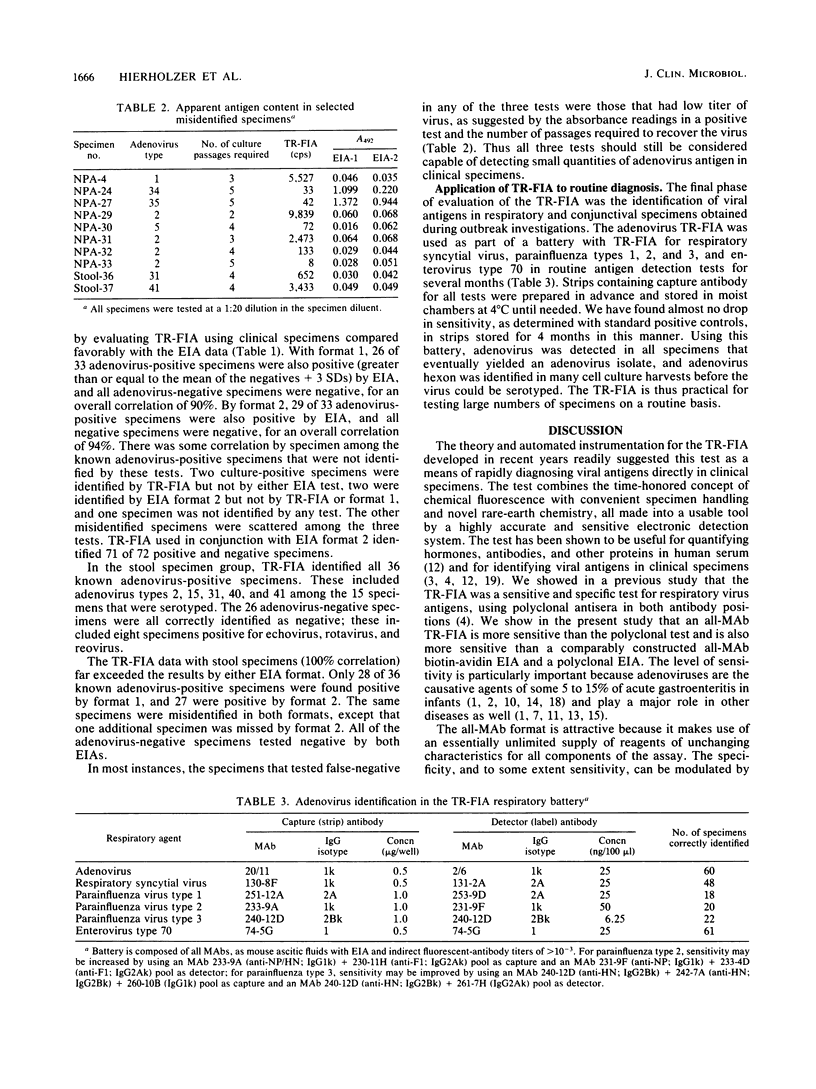
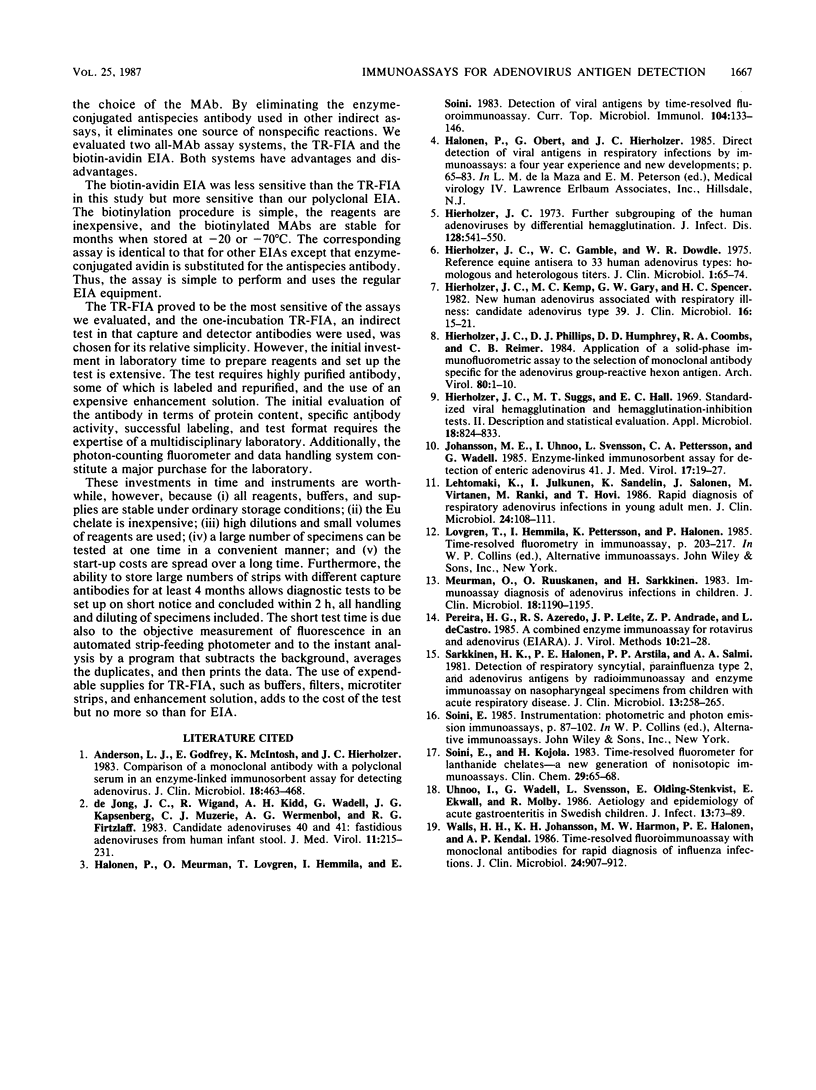
Selected References
These references are in PubMed. This may not be the complete list of references from this article.
- Anderson L. J., Godfrey E., McIntosh K., Hierholzer J. C. Comparison of a monoclonal antibody with a polyclonal serum in an enzyme-linked immunosorbent assay for detecting adenovirus. J Clin Microbiol. 1983 Sep;18(3):463–468. doi: 10.1128/jcm.18.3.463-468.1983. [DOI] [PMC free article] [PubMed] [Google Scholar]
- Halonen P., Meurman O., Lövgren T., Hemmilä I., Soini E. Detection of viral antigens by time-resolved fluoroimmunoassay. Curr Top Microbiol Immunol. 1983;104:133–146. doi: 10.1007/978-3-642-68949-9_8. [DOI] [PubMed] [Google Scholar]
- Hierholzer J. C. Further subgrouping of the human adenoviruses by differential hemagglutination. J Infect Dis. 1973 Oct;128(4):541–550. doi: 10.1093/infdis/128.4.541. [DOI] [PubMed] [Google Scholar]
- Hierholzer J. C., Gamble W. C., Dowdle W. R. Reference equine antisera to 33 human adenovirus types: homologous and heterologous titers. J Clin Microbiol. 1975 Jan;1(1):65–74. doi: 10.1128/jcm.1.1.65-74.1975. [DOI] [PMC free article] [PubMed] [Google Scholar]
- Hierholzer J. C., Kemp M. C., Gary G. W., Jr, Spencer H. C. New human adenovirus associated with respiratory illness: candidate adenovirus type 39. J Clin Microbiol. 1982 Jul;16(1):15–21. doi: 10.1128/jcm.16.1.15-21.1982. [DOI] [PMC free article] [PubMed] [Google Scholar]
- Hierholzer J. C., Phillips D. J., Humphrey D. D., Coombs R. A., Reimer C. B. Application of a solid-phase immunofluorometric assay to the selection of monoclonal antibody specific for the adenovirus group-reactive hexon antigen. Arch Virol. 1984;80(1):1–10. doi: 10.1007/BF01315289. [DOI] [PubMed] [Google Scholar]
- Hierholzer J. C., Suggs M. T., Hall E. C. Standardized viral hemagglutination and hemagglutination-inhibition tests. II. Description and statistical evaluation. Appl Microbiol. 1969 Nov;18(5):824–833. doi: 10.1128/am.18.5.824-833.1969. [DOI] [PMC free article] [PubMed] [Google Scholar]
- Johansson M. E., Uhnoo I., Svensson L., Pettersson C. A., Wadell G. Enzyme-linked immunosorbent assay for detection of enteric adenovirus 41. J Med Virol. 1985 Sep;17(1):19–27. doi: 10.1002/jmv.1890170104. [DOI] [PubMed] [Google Scholar]
- Lehtomäki K., Julkunen I., Sandelin K., Salonen J., Virtanen M., Ranki M., Hovi T. Rapid diagnosis of respiratory adenovirus infections in young adult men. J Clin Microbiol. 1986 Jul;24(1):108–111. doi: 10.1128/jcm.24.1.108-111.1986. [DOI] [PMC free article] [PubMed] [Google Scholar]
- Meurman O., Ruuskanen O., Sarkkinen H. Immunoassay diagnosis of adenovirus infections in children. J Clin Microbiol. 1983 Nov;18(5):1190–1195. doi: 10.1128/jcm.18.5.1190-1195.1983. [DOI] [PMC free article] [PubMed] [Google Scholar]
- Pereira H. G., Azeredo R. S., Leite J. P., Andrade Z. P., De Castro L. A combined enzyme immunoassay for rotavirus and adenovirus (EIARA). J Virol Methods. 1985 Jan;10(1):21–28. doi: 10.1016/0166-0934(85)90084-9. [DOI] [PubMed] [Google Scholar]
- Sarkkinen H. K., Halonen P. E., Arstila P. P., Salmi A. A. Detection of respiratory syncytial, parainfluenza type 2, and adenovirus antigens by radioimmunoassay and enzyme immunoassay on nasopharyngeal specimens from children with acute respiratory disease. J Clin Microbiol. 1981 Feb;13(2):258–265. doi: 10.1128/jcm.13.2.258-265.1981. [DOI] [PMC free article] [PubMed] [Google Scholar]
- Soini E., Kojola H. Time-resolved fluorometer for lanthanide chelates--a new generation of nonisotopic immunoassays. Clin Chem. 1983 Jan;29(1):65–68. [PubMed] [Google Scholar]
- Uhnoo I., Wadell G., Svensson L., Olding-Stenkvist E., Ekwall E., Mölby R. Aetiology and epidemiology of acute gastro-enteritis in Swedish children. J Infect. 1986 Jul;13(1):73–89. doi: 10.1016/s0163-4453(86)92348-0. [DOI] [PubMed] [Google Scholar]
- Walls H. H., Johansson K. H., Harmon M. W., Halonen P. E., Kendal A. P. Time-resolved fluoroimmunoassay with monoclonal antibodies for rapid diagnosis of influenza infections. J Clin Microbiol. 1986 Dec;24(6):907–912. doi: 10.1128/jcm.24.6.907-912.1986. [DOI] [PMC free article] [PubMed] [Google Scholar]
- de Jong J. C., Wigand R., Kidd A. H., Wadell G., Kapsenberg J. G., Muzerie C. J., Wermenbol A. G., Firtzlaff R. G. Candidate adenoviruses 40 and 41: fastidious adenoviruses from human infant stool. J Med Virol. 1983;11(3):215–231. doi: 10.1002/jmv.1890110305. [DOI] [PubMed] [Google Scholar]


